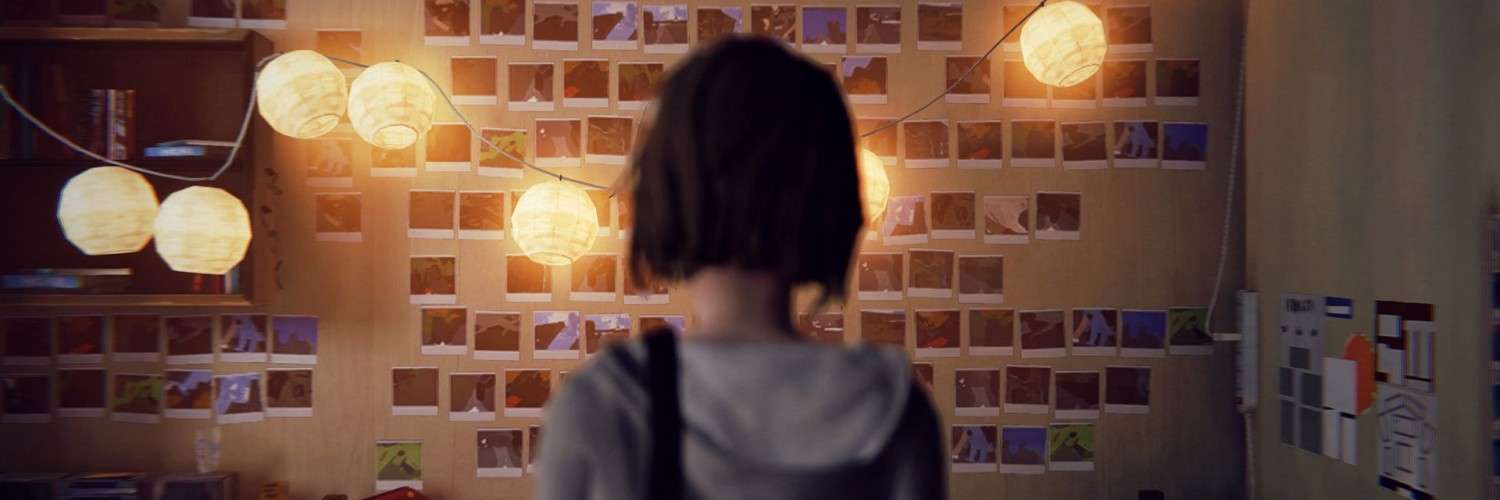
Designing Life is Strange: Dontnod’s Raoul Barbet and Michel Koch at PLAY15
During this year’s PLAY15, a creative video gaming festival, there were plenty of opportunities to speak to developers, participate in workshops and to get a glimpse at what Creative Gaming, the initiative that hosts this annual festival, does with games. Apart from playing them the way you are supposed to, the festival showcases the many ways games can be used as a tool for creativity and demonstrates what this medium has to offer. A major part of the festival that took place in Hamburg is the international PLAY Conference. Lots of interesting guests were invited to talk about games.
The focus this year was on emotions, and how they are shown, evoked or conveyed. The keynote speakers were Raoul Barbet and Michel Koch, Co-Game Directors of Life is Strange, an episodic modern adventure that has been subjects for various discussions about games and their future. In an interview the French developers from DONTNOD Entertainment talked about the fears and doubts they had while working on Life is Strange, their experiences developing the game, and how emotions in games can influence how gamers choose to interact with the medium.
The setting and its inspiration
One of the first questions asked was how emotional moments were created for Life is Strange. Barbet and Koch, both of them having worked on Remember Me, responded that inspiration came from their previous effort. They took the much vague and cruder ideas from that, whilst keeping the consequence of change, and looked to find interesting ways to play with such a feature. They wanted to stress the aforesaid features while telling a story that plays with the implications of memories and time.
The first obstacle they encountered was to create a character that would instill feelings of change and consequence in players. Placing the game in a High School setting was a part of this – as it is a period of intense change and decision for all people. Max embodies these decisions. She hesitates, is focused on the past (which becomes particularly evident by using the polaroid camera), but also grows up throughout the episodes, as the player is supposed to do as well. The slow pace of the game allows Dontnod to contour the past and frame the story so that no one rushes through the game without having learnt about Arcadia Bay and its inhabitants.
Another important aspect of Life is Strange is that it is episodic. Every episode emphasises something different, and it was clear from the beginning that there were going to be five episodes. The plot was written by a French writer (Jean-Luc Cano), who is responsible for the main plot and also worked on Remember Me. However, an American writer (Christian Divine) was employed afterwards to make the story more authentic and add a sense of realism regarding how people deal with feelings, how teenagers behave, and what it is like to be in high school. However, even as episodes were released, the work was not over. Barbet and Koch stated that they looked at the feedback they received, for instance in the form of Let’s Plays. According to what players liked, there were slight changes made, but the story itself remained as it was determined from the beginning.
How to deal with the devil
Addressing problematic, highly discussed and polarising issues in a game as well as in any other media brings certain dangers and difficulties. Barbet and Koch explained that they wanted to address these properly. Life is Strange shows issues like domestic violence, a subject many can relate to, but mainstream games rarely do this. As DONTNOD Entertainment had no financial pressure, and as this was a smaller game for publisher Square Enix (who really liked it, but did not want to change anything about asking players to make difficult choices), they tried to incorporate unpleasant subjects that bigger games avoid, although can still be part of people’s everyday life. During development they claimed to have had doubts whether the public would accept their way of dealing with these issues. They declared the studio was always extremely cautious and respectful to the material despite the immediacy in which the subjects were presented to players.
Some people wondered whether the developers feared that allowing rewinding could ruin the game’s illusion of choice, thus ruining the game’s whole concept. As it turned out, many players chose not to rewind to make a choice. According to Koch and Barbet this was there intention: you have to choose and then go on. There is no black and white, nor wrong or right, everything has long and short-term consequences. The real life choices were designed to make it more realistic and let the players identify with the characters while thinking about decisions they made or might have to make. Koch and Barbet also noted that stats show players were mostly nice and chose a non-violent and friendly interaction when they had the chance to retaliate or do harm.
The importance of being sensitive
In regards to those doubts and fears, it was important to Koch and Barbet to build a strong character. They needed one that experienced change (a technique they learned from film) and also used archetypes to create an easy entry for players. Even minor characters have flaws and are elaborately designed, they are not good or bad, but somewhere in between. Some scenes are more cinematic than we are used to seeing in games. Music, camera and dialogue are chosen in a specific way in order to convey emotion and to emphasize the importance of a decision players are about to make. Moreover, Barbet and Koch explained that they made an effort to link characters and players. There are endless scenes in which you can just sit and wait, or do something else like play guitar, water a plant or reflect on your feelings and happenings. Players can enjoy calm scenes as long as they want to. The stress in action sequences is, as Barbet and Koch expounded, directly opposed to cooldown phases. The different pacing in each episode reflects an evolution the game itself is going through as well as the plot.
Detail-orientated development
Besides the importance of proper characters, the classical writing process included flow, pace and story, which were all thought through. First, Barbet and Koch stated they started with graphs and divided episodes into scenes as they began to layout the game, but this ended up changing. Things were moved or even removed in order to get the best possible experience for the player, resulting in a plot that would fit the intention and direction of the game. While developing the game, they paid much attention to detail: The players can learn more by reading magazines or newspapers and get more involved in the game’s universe. The environment itself tells a story, but is not forced on the player, who can choose whether they desire to take time to learn more about the world. However, the game rewards players with additional information if they choose to interact, yet these are not necessary in order to enjoy the game. Still, they are important if you really want the complete Life is Strange experience, and offer very interesting insights as to why a certain character acts one way or another. If there is a stain on the floor and the player clicks on it, it is not simply “Oh, there is a stain there,” but “Oh, the stain there… I remember how Chloe and I spilled something here.“.
The process of developing something special
When there are two working on one project, chances are they may not agree on anything. Barbet and Koch, both Co-Game Directors of Life is Strange, support each other and mostly agree (though not always) and work on their own preferences. They try to find the right balance for the game, which is their main goal. After receiving the script from the writer, they changed the original story to make it more interactive, but there were no major alterations. They focused on why players should feel a certain way rather than what they would feel. In addition, they started with drafts of various protagonists, but felt Max was the right one for the game. They did not intentionally choose the gender, instead they wanted the perfect character, whichever gender he or she might have had.
Quickly the question arose how male players identify with a female teenager, if they could do it at all. Barbet and Koch commented players could relate to the memories they share from one’s own experiences as a teenager. Whilst other games ask players to identify with an assassin or CIA agent, everybody has gone through that phase of becoming an adult, making decisions and not clearly knowing where to go and where to eventually end up. As an example they talked about Buffy: despite the partly feminist writing many men could identify with certain aspects of the character. Life is Strange is the same, but different. Max is shy, thus does not talk a lot, but has a lot of thoughts she shares with the player; she is even humoristic and ironic, your typical everyday girl and thus easy to identify with.
Games can be seen as a way to escape, however Life is Strange is not one of those games. It is an everyday adventure that gets exciting. For Barbet and Koch it was great to see people play and react to their game, form theories (some of which were “crazy”) and talk about consequences. They aimed for a feeling of having a self-cultivated experience depending on one’s choices. Before they began releasing episodes, they did not know what the audience would look like. They had no idea who would play the game nor did they know how they’d react, but they set their sights on creating a game they were enthusiastic and passionate about from the outset.
Cinematic approaches to everyday experiences
Music mirroring the characters and their development throughout the episodes is one of the more subtle gems of Life is Strange. An unique element regarding the music and its influence on the player’s reception is that the player can choose to play music in certain scenes. It depends on their actions whether there is music or not, sometimes they can even choose between several songs. The music contains licensed tracks from French musicians and also others like Amanda Palmer. (Soundtrack listing)
Beside the music and cinematic scenes, there are various elements that let us differentiate between a film and a game. The element of interaction is one of them. Unfortunately many games simply offer the illusion of having a choice and cannot fully involve the player’s mind and decisions in the gameplay and plot. Life is Strange claims to make a difference here. Obviously there is a plot which the game follows, that is supposed to change depending on the choices a player makes. However, it is impossible to branch the game every time a decision is made. Apparently people play the game several times and do not complain about the impact, or lack thereof, some decisions make. Thus, even though some changes seem severe, they may not make large changes to the world towards the end of the story.
To conclude, Koch and Barbet emphasized that the journey matters more than the eventual outcome, the feeling of owning a personal story is more important than the finale.
In the end…
…it is not about the result you get. It’s the realization that your choices will continually have impact. The fact that decisions you make alter your journey towards the end is more important than what happens at the end. It is not about who dies, who lives, rather about the player recognizing that they are altering the game and coherently changing the experience. Life is Strange is not a game meant to be played as any other, you do not follow a path that leads you somewhere, you are not a passive observer that gets to play from time to time. The game is a framework employed to show you how anything you do alters the future and it is about that epiphany. As we learned, the characters and setting are designed to let players identify with them and to draw a connection to their own lives. Therefore, the game is a narrative with interactive features in order to make the player realise the connection between choice and consequence, the connection between Max Caulfield and themselves.
Having heard all of this, for me Life is Strange is even more a milestone of gaming than it was already. And as a little bit of trivia right from the source that created it: Max’s last name is not a coincidence. “Caulfield” is a reference to “The Catcher in the Rye”.
The speakers
Michel Koch started his career in 2003 as a freelance illustrator. Since then, he has worked on many well-known franchises such as Call of Cthulhu, Game of Thrones and Vampire: the Masquerade. In 2006 he began working in the video game industry as a freelance concept artist. In 2008 he joined DONTNOD Entertainment as a lead concept artist, then as the co-art director alongside art director Aleksi Briclot. They worked together on building the visual universe of the game Remember Me (published by Capcom). He also worked heavily on the environmental storytelling of the game’s universe, collaborating closely with the lead writer. He is now the co-game director and art director of Life Is Strange.
Raoul Barbet is the co-Game Director of the game Life is Strange. After studying engineering, he specialized in project management and production pipeline, particularly in cultural and audiovisual fields. He worked for festivals in Canada and France and as technical coordinator for the Bophana Audiovisual Resources Center in Phnom Penh, Cambodia. His first videogame work was for Quantic Dream’s Heavy Rain, working two years on motion capture and scene game design. He joined then Illumination Mac Guff animation studio (Despicable Me series) as a layout artist for the animated feature film The Lorax and then DONTNOD Entertainment to work on the cinematic and narrative elements of the game Remember Me. He’s now the co-Game Director of Life is Strange.








